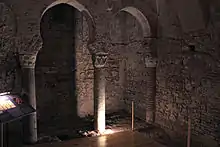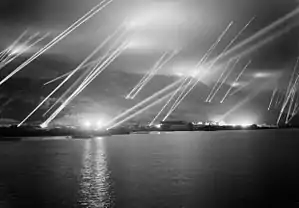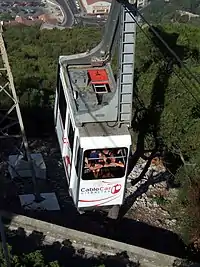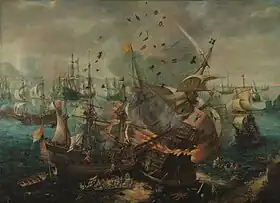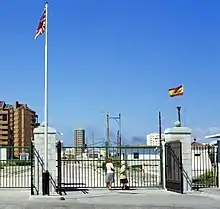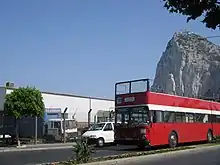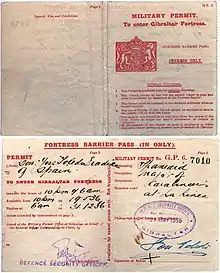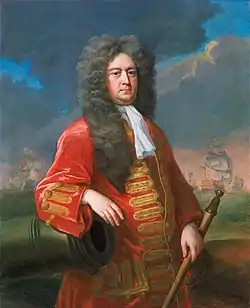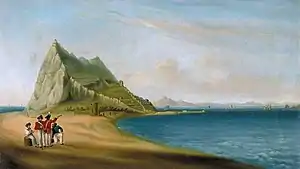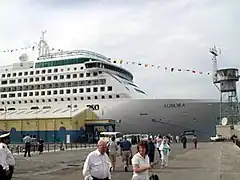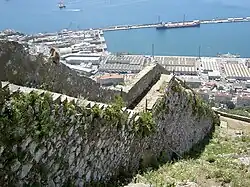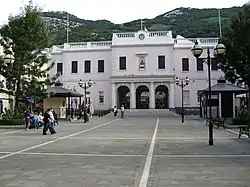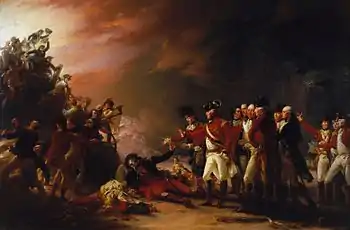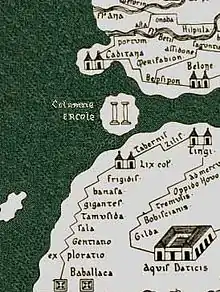The Gibraltar Portal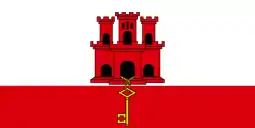 Gibraltar (/dʒɪˈbrɔːltər/ jih-BRAWL-tər, Spanish: [xiβɾalˈtaɾ]) is a British Overseas Territory and city located at the southern tip of the Iberian Peninsula. It has an area of 6.7 km2 (2.6 sq mi) and is bordered to the north by Spain (Campo de Gibraltar). The landscape is dominated by the Rock of Gibraltar, at the foot of which is a densely populated town area, home to some 32,688 people (2022 estimate), primarily Gibraltarians. In 1704, Anglo-Dutch forces captured Gibraltar from Spain during the War of the Spanish Succession. The territory was ceded to Great Britain in perpetuity under the Treaty of Utrecht in 1713. It became an important base for the Royal Navy, particularly during the Napoleonic Wars and World War II, as it controlled the narrow entrance and exit to the Mediterranean Sea, the Strait of Gibraltar, which is only 14.3 km (8.9 mi) wide. This choke point remains strategically important, with half the world's seaborne trade passing through it. Gibraltar's economy is based largely on tourism, online gambling, financial services, and bunkering. With one of the world's lowest unemployment rates, the largest part of the labour force are resident in Spain or non-Gibraltarians, especially in the private sector. The sovereignty of Gibraltar is a point of contention in Anglo-Spanish relations, as Spain asserts a claim to the territory. Gibraltarians overwhelmingly rejected proposals for Spanish sovereignty in a 1967 referendum, and for shared sovereignty in a 2002 referendum. Nevertheless, Gibraltar maintains close economic and cultural links with Spain, with many Gibraltarians speaking Spanish as well as a local dialect known as Llanito. (Full article...) Selected article -Operation Flavius (also referred to as the Gibraltar killings) was a military operation in which three members of the Provisional Irish Republican Army (IRA) were controversially shot dead by the British Special Air Service (SAS) in Gibraltar on 6 March 1988. The trio were believed to be planning a car bomb attack on British military personnel in Gibraltar. They were shot dead while leaving the territory, having parked a car. All three were found to be unarmed, and no bomb was discovered in the car, leading to accusations that the British government had conspired to murder them. An inquest in Gibraltar ruled that the authorities had acted lawfully but the European Court of Human Rights held that, although there had been no conspiracy, the planning and control of the operation was so flawed as to make the use of lethal force almost inevitable. The deaths were the first in a chain of violent events in a fourteen-day period. On 16 March, the funeral of the three IRA members was attacked, leaving three mourners dead. At the funeral of one, two British soldiers were killed after driving into the procession in error. In late 1987, British authorities became aware of an IRA plan to detonate a bomb outside the governor's residence in Gibraltar. On the day of the shootings, known IRA member Seán Savage was seen parking a car near the assembly area for the parade; fellow members Daniel McCann and Mairéad Farrell were seen crossing the border shortly afterwards. As SAS personnel moved to intercept the three, Savage split from McCann and Farrell and ran south. Two soldiers pursued Savage while two others approached McCann and Farrell. The soldiers reported seeing the IRA members make threatening movements when challenged, so the soldiers shot them multiple times. All three were found to be unarmed, and Savage's car did not contain a bomb, though a second car, containing explosives, was later found in Spain. Two months after the shootings, the documentary "Death on the Rock" was broadcast on British television. Using reconstructions and eyewitness accounts, it presented the possibility that the three IRA members had been unlawfully killed. (Full article...)Selected picture Gibraltar Barbary Macaque Photo credit: User:RedCoat10
A Barbary Macaque (Macaca sylvana) in Gibraltar. The Rock of Gibraltar is home to the last wild monkey population in all of Europe, where popular belief holds that as long as Barbary Macaques exist on Gibraltar, the territory will remain under British rule.
Selected quote
SubcategoriesSelect [►] to view subcategories
Gibraltar Gibraltar-related lists Buildings and structures in Gibraltar Gibraltarian culture Economy of Gibraltar Education in Gibraltar Environment of Gibraltar Geography of Gibraltar Gibraltarian people Government of Gibraltar Health in Gibraltar History of Gibraltar Organisations based in Gibraltar Politics of Gibraltar Society of Gibraltar Images of Gibraltar Gibraltar stubs Selected biography -
Field Marshal Sir Alexander George Woodford, GCB, KCMG (15 June 1782 – 26 August 1870), was a British Army officer. After taking part in the Anglo-Russian invasion of Holland, he served in most of the battles of the Napoleonic Wars. During the Hundred Days he commanded the 2nd battalion of the Coldstream Guards at the Battle of Quatre Bras, the Battle of Waterloo and the storming of Cambrai. He went on to become lieutenant governor and brigade commander at Malta, lieutenant governor and brigade commander at Corfu and then commander of the British garrison on the Ionian Islands before being appointed Governor and Commander-in-Chief of Gibraltar. (Full article...)
Did you know...
General imagesThe following are images from various Gibraltar-related articles on Wikipedia.
Topics Buildings: The Convent | Dudley Ward Tunnel | Garrison Library | Moorish Castle Communications: .gi | Gibraltar Broadcasting Corporation | Gibraltar Chronicle | Telecom dispute Culture: Cuisine | Gibraltarian people |Gibraltarian status | Languages | Llanito | Music Flora and fauna: Gibraltar Barbary Macaques | Gibraltar candytuft | GONHS | List of birds of Gibraltar | Mammals | List of reptiles and amphibians in Gibraltar | Rock of Gibraltar | The Alameda Gardens History: Battle of Gibraltar | Death on the Rock | Explosion of the RFA Bedenham | George Augustus Eliott, 1st Baron Heathfield | George Rooke | Gibraltar real | Great Siege of Gibraltar | History of the Maltese | History of Nationality | Kingdom of Gibraltar | Military history of Gibraltar during World War II | Moorish Castle | Aurora incident | Pillars of Hercules | Treaty of Utrecht Military: British Forces Gibraltar | Royal Gibraltar Regiment | RAF Gibraltar | HMS Gibraltar | Gibraltar Services Police | Royal Gibraltar Police Symbols: Coat of arms | Flag | Gibraltar Anthem | Other Flags Politics and economy: Chief Minister | Constitution Order (1969, 2006) | Disputed status | Elections | Gibraltar Constitution Order 2006 | Parliament | Gibraltarian pound | Governor | Political parties Religion: Cathedral of St. Mary the Crowned | Cathedral of the Holy Trinity | Great Synagogue | Hinduism | History of the Jews in Gibraltar | Ibrahim-al-Ibrahim Mosque | Methodism | Roman Catholicism | St Andrew's Church Related portalsThings you can do
See also
WikiProjects
Associated WikimediaThe following Wikimedia Foundation sister projects provide more on this subject:
Discover Wikipedia using portals
| ||||||||||||||
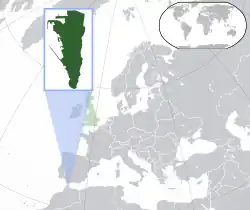


.jpg.webp)



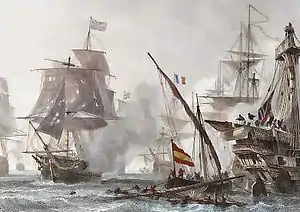
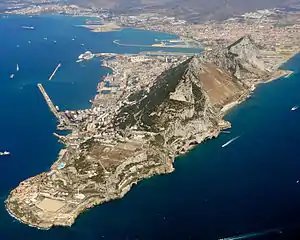
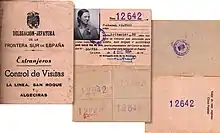
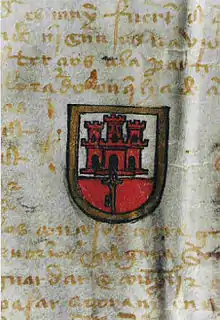
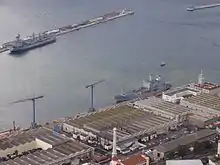
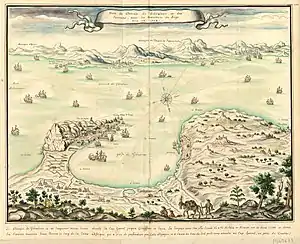
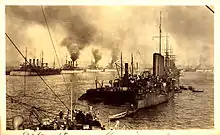

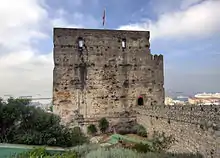
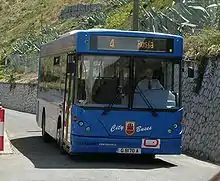
_(2).jpg.webp)
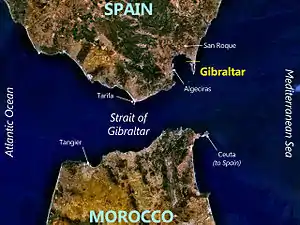

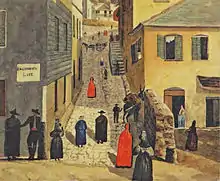
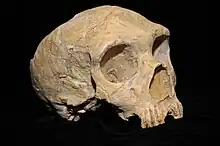
.jpg.webp)
